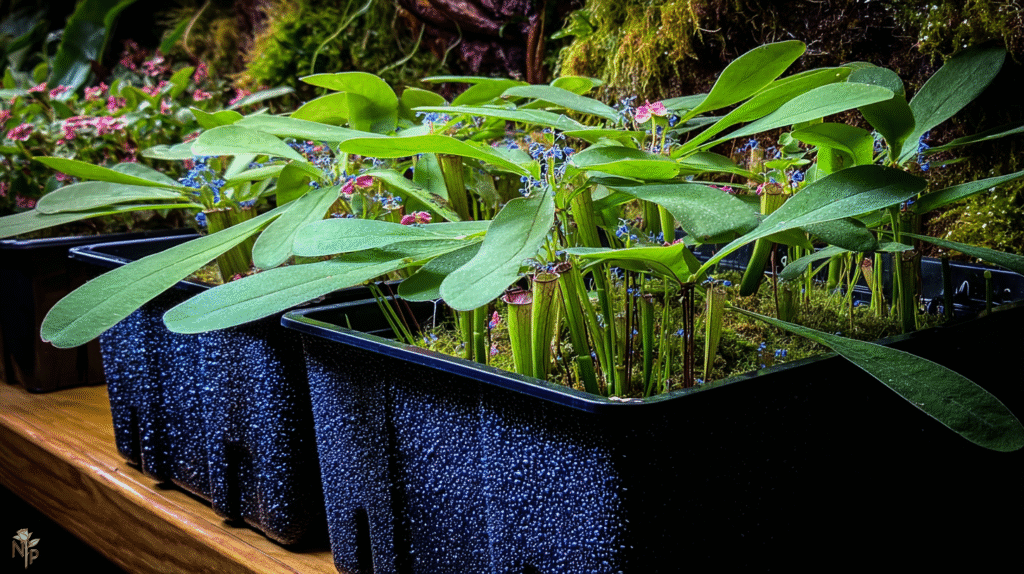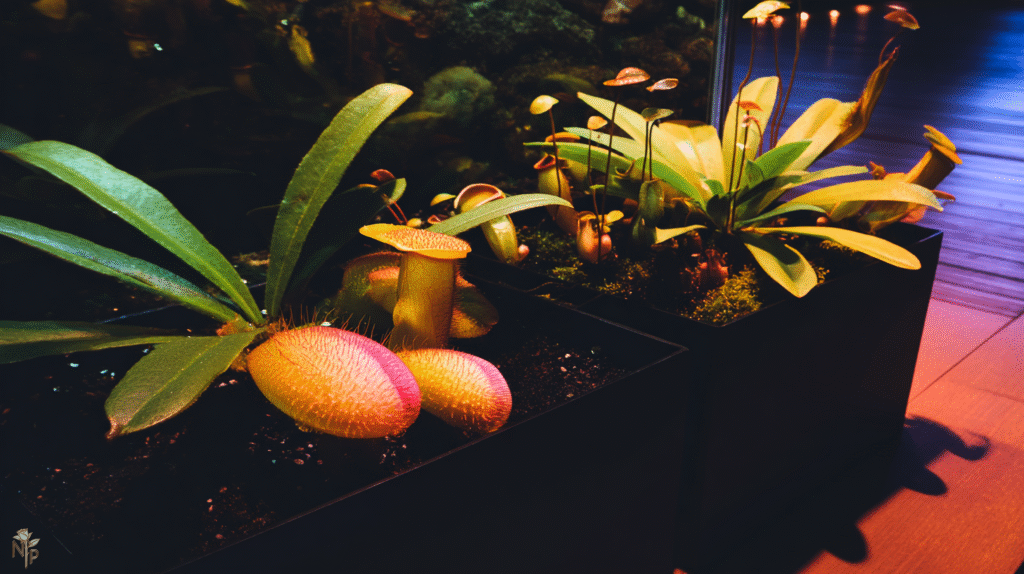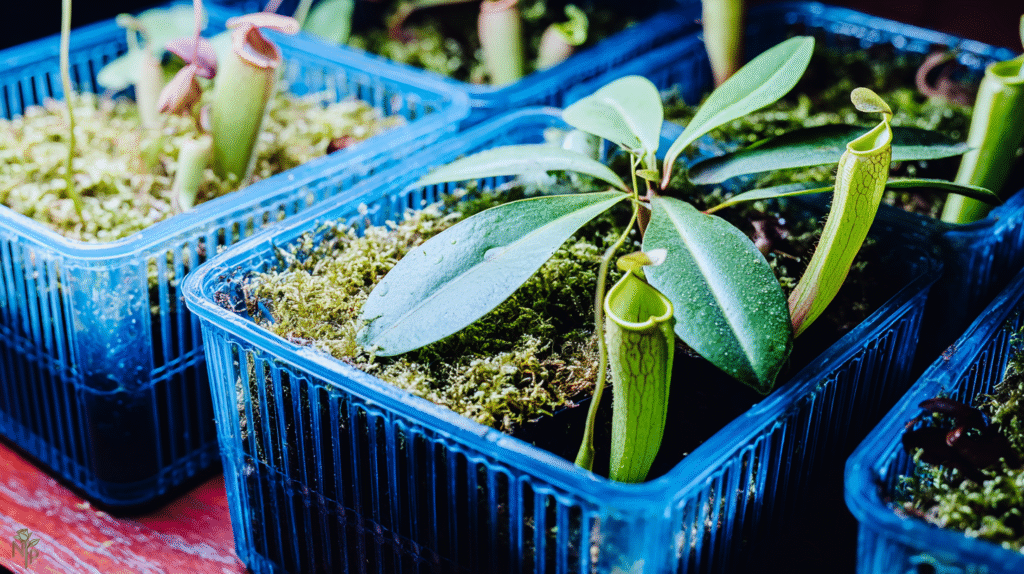My first pitcher plant lasted eight days. EIGHT DAYS. This thing that supposedly eats bugs and survives in swamps couldn’t survive a week in my apartment. I’d watered it with tap water (mistake #1), put it on a sunny windowsill (mistake #2), and planted it in regular potting soil (mistake #3). It turned black and melted like the Wicked Witch of the West.
But I’m stubborn and pitcher plants look like alien tentacles, so obviously I had to try again. And again. And again.
Five dead plants and about $150 later, I finally cracked the code. Now I’ve got seven different pitcher plants, including one Nepenthes that’s literally taking over my bathroom ceiling and a Sarracenia that caught a wasp last week (most satisfying thing I’ve ever watched). Turns out these things aren’t hard to grow – they just want the exact opposite of what every other houseplant wants.
The Water Situation That Changes Everything
This is what kills 90% of pitcher plants: tap water. Our tap water is basically poison to them. All those minerals and chemicals that are fine for us? Pitcher plants hate them more than I hate small talk.
What actually works:
- Distilled water (dollar store, $1 per gallon)
- Rainwater (free but requires collection setup)
- Reverse osmosis water (if you’re fancy)
Never tap water. Never filtered water (Brita doesn’t remove enough minerals). Never “let it sit overnight” tap water. I killed two plants thinking filtered water was good enough. It’s not.
I buy distilled water by the case now. Yes, it’s annoying hauling water from the store. Yes, my friends think I’m insane. But it costs me maybe $3 a week to keep seven plants happy, and they’re not dying anymore, so who’s laughing now?
The tray method that saved my sanity: Pitcher plants want to sit in water. Like, literally sit in it. I put the pots in trays with 1-2 inches of distilled water at all times. Never let it dry out. This blew my mind because every other plant I own would get root rot from this treatment.
My Sarracenia (North American pitchers) sit in deeper water in summer – sometimes 3 inches. They’re bog plants. They want to feel like they’re in a swamp. In winter I reduce it to just 1 inch, but never dry.

Light Requirements (Way More Than You Think)
The care tag said “bright indirect light.” The care tag was written by liars.
Sarracenia (North American pitchers): These want FULL SUN. Like, blast-them-with-light full sun. Mine are under a grow light for 14 hours a day and they want more. When I had one in “bright indirect light,” it grew tall, thin, pathetic pitchers that couldn’t catch anything. Moved it under grow lights and boom – fat, colorful pitchers that actually work.
Nepenthes (Tropical pitchers): These are the only ones that actually like bright indirect light. My bathroom Nepenthes gets morning sun through a frosted window and it’s growing like it’s on steroids. But even these want more light than you’d think. The one in my darker bedroom barely makes pitchers.
I use a $40 LED grow light from Amazon for my Sarracenia. Not the purple ones – those make your room look like a crime scene. The white full-spectrum ones. Keep them 6-12 inches from the plants, run them 12-14 hours daily. My electric bill went up maybe $5 a month.
Without enough light, pitcher plants can’t make pitchers. They’ll grow leaves but no traps. What’s the point of a pitcher plant without pitchers? That’s like having a cactus that’s soft.
Soil That Makes No Sense But Works
Regular potting soil will kill pitcher plants faster than anything else. They want nutrient-FREE soil. Yes, you read that right. The soil should have basically zero nutrients.
My mix that works:
- 50% sphagnum peat moss (not regular peat, specifically sphagnum)
- 50% perlite or sand (coarse, not fine)
That’s it. No fertilizer, no compost, no nutrients. The first time I made this mix, I kept thinking I was forgetting something. Nope. They get their nutrients from bugs, not soil.
You can also use pure long-fiber sphagnum moss, which is what I use for my Nepenthes. It’s expensive ($20 for a small bag) but works amazing. Holds moisture but stays airy. My biggest Nepenthes has been in the same sphagnum for two years, still thriving.
Never use Miracle-Gro anything. That fertilizer they add to everything will nuke your pitcher plants. Learned this the hard way with my third dead plant.
Temperature Drama (Depends on the Type)
This is where it gets complicated because different pitcher plants want different things.
Sarracenia (North American): These NEED winter dormancy. Like, they need to get cold (35-45°F) for 3-4 months or they’ll die. I thought I could skip this. Plant died by the following summer. Now mine spend winter in my unheated garage near a window. They look dead all winter, then explode with growth in spring.
Room temperature year-round will kill them slowly. Trust me, tried it twice. They’ll struggle through one year, maybe two, then give up. The dormancy isn’t optional.
Nepenthes (Tropical): These want it warm and humid always. No dormancy. Mine are happiest at 70-85°F. The bathroom one loves shower humidity. I’ve got another in my bedroom with a humidifier nearby. Below 60°F and they sulk. Below 50°F and they start dying.
Highland Nepenthes (like N. ventricosa) can handle cooler nights, down to 55°F. Lowland ones want it warm 24/7. Found this out when my “easy” lowland Nepenthes nearly died during a cold snap.

Humidity Hacks That Actually Work
Sarracenia don’t care much about humidity if their roots are wet. But Nepenthes? These drama queens want 50-70% humidity minimum.
What doesn’t work:
- Misting (just makes leaves wet, doesn’t raise humidity, causes fungus)
- Pebble trays (raises humidity maybe 5%, basically useless)
- Terrariums for adult plants (not enough air circulation, everything rots)
What does work:
- Actual humidifier ($30 investment, game-changer)
- Bathroom placement if you have a window
- Grouping plants together
- Clear plastic bags over small plants (ghetto but effective)
My bathroom Nepenthes grows pitchers 6 inches long because the shower humidity keeps it at 60-70%. The bedroom one with just a humidifier makes smaller pitchers but still healthy.
Feeding (Or Not)
Here’s the thing – if they’re outside or catching bugs inside, don’t feed them. They know what they’re doing. My outdoor Sarracenia catch so many flies and wasps I actually feel bad for the bugs. Almost.
But if they’re inside not catching anything, you can feed them:
- Freeze-dried bloodworms (fish food, rehydrate first)
- Dead bugs (I feed mine dead flies from windowsills)
- Fish food pellets (one per pitcher monthly)
Never hamburger or lunch meat. It’ll rot and kill the pitcher. Found this out when I tried feeding one ham. Pitcher turned black and died. Lesson learned.
My indoor Nepenthes get one bloodworm per pitcher per month. That’s it. Overfeeding kills pitchers faster than underfeeding. These aren’t pets that need daily meals.
The Mistakes That Cost Me $150
Using tap water: Killed plants #1 and #2 Wrong soil: Killed plant #3 No winter dormancy for Sarracenia: Killed plant #4 Thinking “low light tolerant” meant dark corner: Killed plant #5
Each dead plant taught me something, but damn, expensive education.
My Current Setup That Works
Sarracenia collection:
- Outside March through November on sunny deck
- Sitting in trays of distilled water
- In garage for winter dormancy
- Zero fertilizer ever
Indoor Nepenthes:
- Bathroom one: hanging in shower window
- Bedroom ones: near humidifier, under grow light
- Distilled water only, keep moss moist but not soaked
- Feed monthly if not catching bugs

Why These Weird Plants Are Worth the Hassle
Watching a pitcher plant catch its first bug is weirdly satisfying. My Sarracenia caught a huge wasp last month and I actually cheered. The Nepenthes in my bathroom has pitchers so perfect they look fake. Plus, they’re conversation starters. Everyone wants to know about the plant with cups hanging off it.
Once you nail the conditions – distilled water, nutrient-free soil, lots of light, proper dormancy – they’re actually pretty low maintenance. I spend maybe 10 minutes a week total on care, mostly just refilling water trays.
The secret is accepting they’re not normal houseplants. They’re bog and rainforest plants that eat bugs. Treat them like the weirdos they are – give them swamp conditions or rainforest humidity, blast them with light, and never give them tap water. Do that and they’ll reward you with pitchers that make everyone ask, “Is that plant eating a bug?”
Yes. Yes it is. And it’s awesome.






